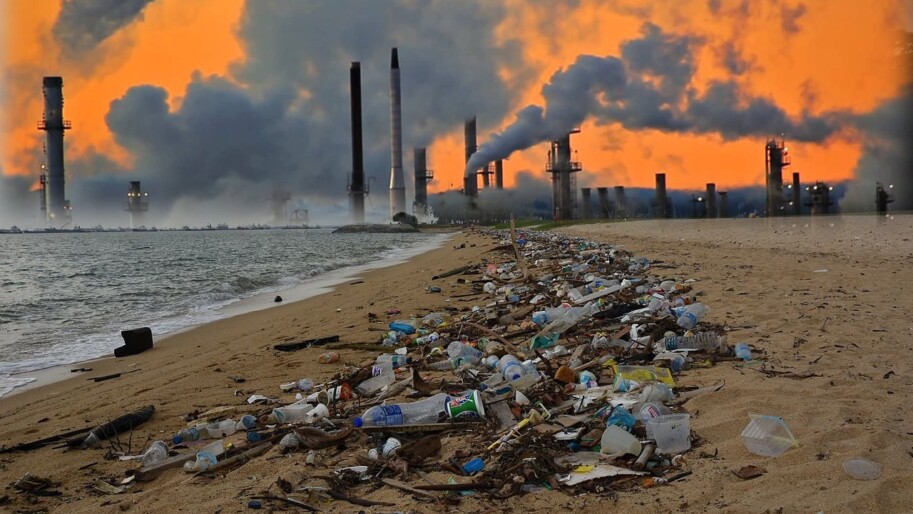What does plastic pollution have to do with climate change? They share a common origin.
My environmental awakening came in 2003 at a presentation about the Great Pacific Garbage patch. Biologists were starting to find dead albatross washed up along coastlines with guts full of plastic. I remember thinking to myself, “If we are allowing this to happen, what else are we allowing to happen?” It did not take long to make my way to reports about climate change. While I came to the conclusion that climate change is the issue that swallows all other issues, plastic pollution is still a close second, with humans dumping more than 8 million tons of trash into the ocean each year.
Fast forward to 2007 to a small building next to a recycling center in the City of El Cerrito – where I was performing a municipal greenhouse gas inventory for ICLEI, an international nonprofit that lends out interns to cities all over the world to perform inventories. Although it was the city’s solid waste manager championing the inventory, conventional knowledge at the time indicated that solid waste (garbage) only represents about one percent of total greenhouse gas emissions. Reducing solid waste to curb greenhouse gas emissions was seemingly not a very smart strategy. The plastics issue would have to give way to the issue of climate change.
The following year, I was with my husband in a small water taxi on Lake Atitlan in Guatemala making our way to a small village called San Marcos when we saw something that shocked us. Two indigenous women dressed in traditional clothing were chatting in their native tongue and eating ice cream on a stick. We were about 75 percent of the way to the village when they finished their ice cream and casually threw their trash overboard mid-sentence, without a second thought. I turned to my husband and said, “It’s outrageous that we bring this technology to indigenous people without explaining that it can’t be used like a banana peel.” It truly was outrageous when we arrived in San Marcos and found an overwhelming amount of plastic garbage that was already so widespread, the residents had begun stuffing it into the plaster walls around town to try to contain it.
Fast forward again to today and I am reading about just how dire the situation is for our oceans. Plastic has been found in the deepest part of the ocean – the Mariana Trench, in the Arctic ice sheet, and in Monterey Bay, which was until now thought to be one of the most pristine bays in California. Furthermore, researchers recently found microplastic in the guts of a random sampling of people from eight countries. It would appear that we are all downstream.
A key culprit in the diaspora of plastics throughout our oceans is the dumping that happens in rivers across Asia. Much of the plastic we throw in the recycling bins here in the US is shipped overseas to supposedly get recycled in Asia. However, huge quantities of plastic are ending up in rivers that carry it out to sea. Various creative ventures have popped up attempting to clean up the mess, including a venture launch out of the San Francisco Bay, but the scope is enormous and the plastics industry is making plans for major growth in the coming decades.
So, what does the plastic plague have to do with climate change?
These problems have a common solution because they share a common origin – the oil industry.
As you may recall, plastic is made of oil. This means that if we shut off the flow of oil at the point where it comes out of the ground – at the wellhead – we not only stop emissions from oil-based liquid fuels such as gasoline, but we also discontinue the feedstock for all the virgin plastic being produced.
The plastics industry (and thus, the oil industry) is worried about the public outcry over plastic, as it should be. Both Bloomberg and Inside Climate News recently ran stories about these worries. There has been a surge in calls for producer responsibility for plastic products when they reach the end of their useful life. However, such calls for producer responsibility don’t actually cover the full cost to society. A new report indicates that the proliferation of single-use plastic around the world is accelerating climate change. The report says that plastic contributes to greenhouse gas emissions at every stage of its lifecycle, from its production and refining to its disposal. Even if producers of that plastic took it back, what about all of the carbon emissions and all the plastic already in our oceans? There is no easy way to take it back.
While the issue of plastics has captured a lot of recent headlines, the Green New Deal has catapulted the issue of climate change to center stage in the politics of the 2020 presidential election. While most politicians now agree that a price on carbon is a part of the solution, not many plans explicitly call for pricing carbon at the point where it is extracted from the ground. If we were to do this, it would have profound implications not only for carbon emissions, but also for plastic. Rather than having to deal with these public burdens downstream in thousands of locations where they become nearly impossible to contain, would it not make more sense to increase political pressure to apply a carbon tax at the wellhead – the central location that is the origin of the blight?
Of course, producer responsibility is key to taming any rampant and damaging externality and establishing rules for the “cradle to grave” lifecycle of products is important. However, the further downstream we go, the more opportunities there are for the oil industry to wiggle out of taking responsibility for the costs society bares while they enjoy private profits. If we are not careful, we will wake up one day and find all of the costs of plastic and carbon pollution foisted upon us at the end of the line – in our oceans, in our bodies, and on us, as tax payers, spending trillions of dollars to clean up messes from climate change impacts like hurricanes, wildfires, and the like. Oh wait, that has already happened. So what are we waiting for?
Time to tax at the wellhead.
To read more about an effective price on carbon, click here>>


